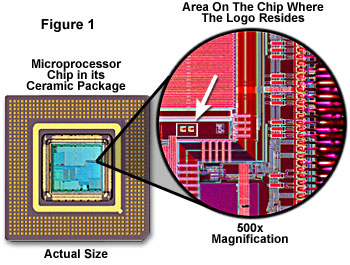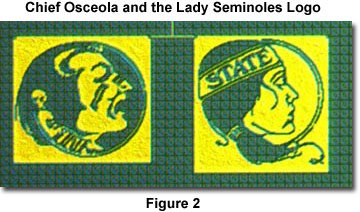The Silicon Zoo
Unpackaging and Photographing Integrated Circuits
Silicon cartoon characters and other doodling are photographed using reflected differential interference contrast (DIC) microscopy and a full-wave retardation plate, sometimes with oblique illumination enhanced by filtered gels. Most chips are packaged in ceramic packages that hide the integrated circuit behind a brass or ceramic cover plate. The first step is removal of the cover plate designed to protect the microprocessor from mechanical damage and humidity. This is done with a scalpel or on a mill to expose the underlying integrated circuit for photomicrography.

The microprocessor package on the left in Figure 1 is a Silicon Graphics MIPS R12000 with the protective cover removed to reveal the microprocessor chip underneath. This is the ideal candidate for photomicrography, because all areas of the chip can be examined without damaging the silicon surface. The packaging serves as a "sample holder" so that the chip can be translated back and forth during observation and photomicrography.
We usually scan the entire chip at low (2.5x to 5x) magnification to identify areas most likely to contain the silicon creatures. These areas are usually found in the voids between registers and caches or near the bonding pads, but many chips also have a "signature" area where the type of chip, designer credits, and company logo are displayed. It is often in this area that designers place the tiny cartoon creatures. The Florida State University Seminole sports logos were found in an area between a large cache and a series of busses, as illustrated on the right in Figure 1. All of the creatures are built into the integrated circuitry during the manufacturing process, and many are rather complex, probably requiring several masks to create.
After a thorough examination of the surface, we will rotate the microscope nosepiece into higher magnification for a first pass at photography of the creatures. The MIPS R12000 has at least six creatures (that we have found so far) and a signature area containing the designers' names. Most of the creatures vary in size from 20 to 200 microns, which will fill the frame of a 35 millimeter camera using 20x to 60x objectives. The Seminole sports logos are about 80 microns in size and were photographed with a 40x objective to yield the photomicrograph illustrated in Figure 2 below.

Chip designers have been placing cartoon characters and other images on integrated circuits for many years. We have discovered over 35 unique designs and many are featured in our Silicon Zoo, along with information about their origin and size. Other creatures that we have heard about, but have never seen, are the Starship Enterprise, a Japanese Superman, and dinosaurs other than the ones described in Silicon Creatures. If you are certain as to the existence of any creatures that we have not featured, please contact us using the email link below and let us know about them.
